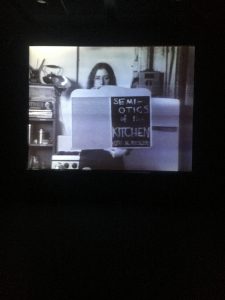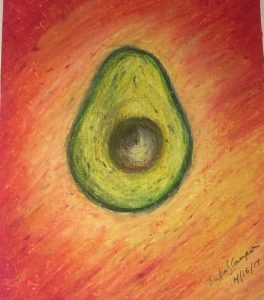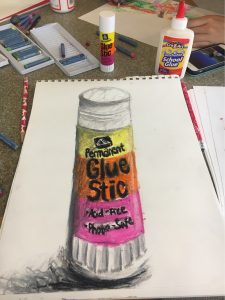 The last time I molded clay was at summer camp when I was a kid, so you cannot believe how excited I was to let out my inner child and go mold clay. The event also provided a nice escape from the typical movie nights I had found myself attending out of necessity due to my schedule with work and class. We got a little history background about the role clay making has played in ancient civilizations and how it changed over time based on the resources available and the culture of the people who sculpted the figurines at the Johnson museum. We were given a block of clay to cut and mold, and were taught bonding techniques to piece the clay together with water. I found my lack of creativity present when given the freedom to turn this block into whatever I desire, so I went with my nerdy instinct and made a small clay model of a Mars rover similar to that of the designs made by my project team in the past. Had I known beforehand what material we were working with I like to believe I could have planned a more elaborate sculpture. Overall I found this activity to be rather relaxing, and a great change from my typical day of classwork and problem sets.
The last time I molded clay was at summer camp when I was a kid, so you cannot believe how excited I was to let out my inner child and go mold clay. The event also provided a nice escape from the typical movie nights I had found myself attending out of necessity due to my schedule with work and class. We got a little history background about the role clay making has played in ancient civilizations and how it changed over time based on the resources available and the culture of the people who sculpted the figurines at the Johnson museum. We were given a block of clay to cut and mold, and were taught bonding techniques to piece the clay together with water. I found my lack of creativity present when given the freedom to turn this block into whatever I desire, so I went with my nerdy instinct and made a small clay model of a Mars rover similar to that of the designs made by my project team in the past. Had I known beforehand what material we were working with I like to believe I could have planned a more elaborate sculpture. Overall I found this activity to be rather relaxing, and a great change from my typical day of classwork and problem sets.
Category Archives: Johnson Museum
Score, THEN Slip!
Art has always had an interesting place in my life. When I was younger, I was forced into it by my parents, thinking that art is something to be appended onto a resume. I withdrew from art for a long period of time, focusing on sciences and subconsciously deriding those who would appreciate and practice art.
From a strictly money-based perspective, art isn’t really too practical. Many people I know like to tout the statistic that only the top 10% of professional artists can live comfortably. I hear stories from my parents of impoverished, yet talented, Chinese artists, willing to sell some admittedly nice looking paintings for a pittance.
As I grew, I started to wonder why people would make themselves undergo such struggles for such superficial benefit. The second time I explored art, I did it on my own volition. Some art classes and orchestra rehearsals later, I think I have a bit of a better idea about art than I did in the days of yore.
Despite my newfound interest in art, I still find traversing museums more onerous than fascinating. Perhaps a few pieces would strike my fancy, and I could appreciate the effort and creativity that went into making said pieces. But, once I’ve seen a hundred or a thousand pieces of similar quality requiring similar skill, I begin to lose interest. I lose my appreciation for beauty once I’m surrounded by it, constantly, for hours on end.
When I visited the small exhibition in the storage room of the Johnson, this was no sprawling expanse of reputable artworks; it was a handpicked collection of relics, practical and realistic articles from central America. The tour guide pointed out things that were, on one hand, obvious, but on the other hand, easy to miss on the first glance. This was especially proven by the “jelly doughnut” teapot, which was actually an oil spill.
I can’t say that I truly appreciate ceramics anymore than I did before, and nor can I say that I was dazzled by the art collection I saw. As I struggled to mold the clay into something that looked more meaningful than an oblong grey lump, however, I did start to understand how much of an endeavor it was to create something practical and nice looking.
Clay at the Johnson
On a rainy Thursday afternoon, I and group of other Rose Scholars made our way up to the Johnson Museum for an afternoon clay making session. After a quick art history lesson where we viewed various Pre-Columbian pieces of clay artwork, we were brought to the studio and given the opportunity to create our own masterpiece.
Inspired by the walk through of the Johnson’s clay collection, I decided to embark on the ambitious task of crafting a full fledged teapot. The last time I had touched a piece of wet clay I was still an avid Jonas Brother’s fan, so needless to say the teapot went south quickly. Regardless, I had fun molding my clay into various shapes and sizes and taking my mind off the endless work I had waiting for me when I got back to my dorm.
The hour went by incredibly quickly and I was reminded why I love attending Rose Events at the Johnson. The activity is always something fun, creative, and surprisingly cathartic to a stressed out college student, and this one was no different.
Technology’s Influence on Art
During my journey through Johnson’s Art Museum on Saturday I can’t help but notice the detail of prints. In days that lack computers or modern photography, prints were used to depict realistic images of the world around them. The artistry, level of accuracy, and scope of these works are inspiring and I can’t help but wonder if artists today can become masters of prints as much as these artists did.
While I am sure there are some people today who can replicate the quality of prints made centuries ago, I wonder what is the difference in the number of the people who has this skill. Out of the populations in the past, what is the percentage of them that know how to make prints.
As technology improves, how many skills are lost due to their lack of usage? Even though the thought that there are an infinite number of skills that has been lost through the centuries is a little bit disheartening, that is the price of “progress”. I guess the art of creating print documentation is replaced by knowledge on how to Photoshop, take pictures with iphones, and how to take pictures under microscopes. What would these technologies be replaced by a hundred years from now? 3-d sculpting? Virtual reality landscape painting?
Our documentation of imagery becomes more realistic every year. With that realism, there is an increase in accuracy in terms of depicting what is real. However we have to be careful to notice that soon the images that we create are no longer just real but realistically distorted, ultimately painting an unrealistic expectation of what is real. Perhaps it is then we should look back at print artworks and realize what is real imagery at its most basic form.
My Clay Sculpting Masterpiece
Last Thursday I attended a clay sculpting event and the Johnson Art Museum. As you may be able to tell from the picture of my final product, I have no experience making clay sculptures. I also did not have any ideas of what to make before starting which made things interesting. I ended up deciding to make a tower and see how tall I could make it. The event was actually quite relaxing partially because I had no expectations of making a nice-looking sculpture. It also reminded me of elementary school art class which brought back some good memories.
I also enjoyed watching other people make their sculptures. Many of the other participants created sculptures that were very good looking. Some of the other participants clearly had a plan coming into the session and brought additional supplies to help them create their masterpiece. Other participants, like me, had no preconceived ideas and experimented with the clay before deciding on what to build.
I thought the clay sculpting event was fun and relaxing. It also allowed me to be creative. There were no rules and the clay could be shaped into almost anything allowing my imagination to run free.
Avocado on the Horizon
Last Saturday I spent part of my day at the Johnson Museum. Although this was not my first time, it always seems as if I discover something new whenever I go. Although I’m not that great of an art “interpreter” per say, it’s always enjoyable looking at the different art forms, genres, and mediums. This time around I encountered a piece that caught my attention, particularly because it was a video. Semiotics o f the Kitchen by Martha Rosler was first released in 1975. The video is six minutes long and portrays a woman in the kitchen presenting several kitchen utensils, each of which stands for a letter in the alphabet. At first I was very confused and even a bit scared, considering the video is played in a dark room with only a bench in the center of the room to watch the video from. The woman in the video demonstrates how to use different utensils in the kitchen which may seem odd in itself, but what makes it even more bizarre is that her motions are aggressive and, for the most part, she doesn’t seem to use the tools correctly at all. Like I said, I was really confused at first (remember I’m not that great at interpreting art) but once I read the description of the piece it made a little more sense to me. Artist Rosler, a well-known feminist, commented on this piece that “when the woman speaks, she names her own oppression”. I’m no expert, but I think she might have been trying to explain how women are undermined and subjicated through media, commercialization, and the “technologies” of the kitchen during this time and even today. Here’s a link to the video online in case you’re interested in checking it out. Perhaps you can add more to the conversation and interpretation than I can. https://www.youtube.com/watch?v=Vm5vZaE8Ysc
f the Kitchen by Martha Rosler was first released in 1975. The video is six minutes long and portrays a woman in the kitchen presenting several kitchen utensils, each of which stands for a letter in the alphabet. At first I was very confused and even a bit scared, considering the video is played in a dark room with only a bench in the center of the room to watch the video from. The woman in the video demonstrates how to use different utensils in the kitchen which may seem odd in itself, but what makes it even more bizarre is that her motions are aggressive and, for the most part, she doesn’t seem to use the tools correctly at all. Like I said, I was really confused at first (remember I’m not that great at interpreting art) but once I read the description of the piece it made a little more sense to me. Artist Rosler, a well-known feminist, commented on this piece that “when the woman speaks, she names her own oppression”. I’m no expert, but I think she might have been trying to explain how women are undermined and subjicated through media, commercialization, and the “technologies” of the kitchen during this time and even today. Here’s a link to the video online in case you’re interested in checking it out. Perhaps you can add more to the conversation and interpretation than I can. https://www.youtube.com/watch?v=Vm5vZaE8Ysc
Once w e left the museum, we walked over to Rose to create some of our own art. When you’re so busy with school, papers, exams, etc. it’s easy to forget about your creative potential! I decided to draw an avocado. . . I named this piece “Avocado on the Horizon”. I had a lot of fun coloring it in with pastels and definitely wouldn’t mind more art sessions throughout my semester!
e left the museum, we walked over to Rose to create some of our own art. When you’re so busy with school, papers, exams, etc. it’s easy to forget about your creative potential! I decided to draw an avocado. . . I named this piece “Avocado on the Horizon”. I had a lot of fun coloring it in with pastels and definitely wouldn’t mind more art sessions throughout my semester!
Imagination: More prevalent in the past or the present?
Last Saturday, I attended the Rose event at the Johnson Museum that exhibits early imaginative art, featuring videos, etchings, and colorful works. I was most intrigued by the intricate etchings of various styles, including ones of dark yet extravagant prisons, ones that served as political satire, and others of creatures. The foresight and practice required to create the image that the artist desires astounds me. It is difficult enough to create the precision of many tiny lines when drawing; but then having to etch out the negative space so that the print itself becomes the image is quite fascinating to me. While I could never attain this level of skill, I did find it very stress relieving for all of us at the event to create our own pieces of artwork. There is something about being creative and patient at the same time that is very rewarding.
After viewing these images and reading the blurbs that described each themed artwork’s imaginative technique or portrayal of a theme, I began to wonder whether one becomes inspired by imagination theoretically more easily much earlier on, or more presently. If in the past, less ideas have been explored, so a new idea is more likely to be actually novel. However, presently, after much more time has passed, much more precedent is available for new ideas to build off of. I realize, though, that it really isn’t important whether it is easier to be creative in the past or the present, as long as learning continues.
Art in Space and Time
Pt. I:
Last Saturday I arrived at the Johnson Museum after volunteering at the Museum of the Earth, and I noticed a completely different environment from where I had spent explaining dinosaur egg diagrams to kids. I have always been big on museums, and these two museums were no exception. I glimpsed “Cosmos,” the LED outdoor ceiling display created in homage to Cornellian astrophysicist Carl Sagan. Comparing this experience side by side to seeing the fossilized creatures on display at the Museum of the Earth, I noted the vastness of the universe across both space and time, and I felt dwarfed by magnificence. We as human beings play such a small role in the grand scheme of things–a both terrifying and comforting thought.
Pt II:
Afterward, we went back to Rose House and created our own art using oil pastels. I loved art in middle school, and my parents would send me to art camp as a child, but being a STEM major, I hadn’t touched oil pastels in years. I found it relaxing to sit for an hour in silence and draw as we pleased. I would definitely love to do more art-based activities in the future, maybe even take a few classes eventually.
Pre-(Country of Choice)
To be quite honest, I’ve never been interested in art history. But on Thursday evening, I found learning about art is far more interesting and deep than I imagined. Art is not just history of the piece. It’s also history of the culture. For example, we learned about a lot of ancient culture. (I call it Pre- culture since everything was labeled like that for identification.) In Pre-Columbian culture, vessels were very popular and even in different time periods and cultures you can tell the strong similarities and added traditions.
One interesting cultural fact I learned is about the Pre-Columbian culture. They had to special animals: birds and cats. These animals were thought to be able to transcend. Birds can fly up into the sky and cats can climb trees all the way up. As an avid lover of cats, it caught my attention immediately.
When we started working with the clay, I immediately decided to create a teapot. It was definitely a far bigger challenge than I imagined. But also so much fun. Unfortunately it is not food safe so will not be a functional teapot but a cute one nonetheless! Thanks so much for the workshop. Definitely one of the best events I’ve attended.



